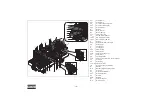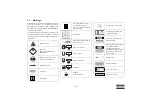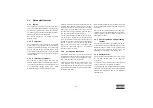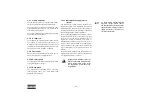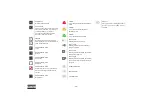
- 21 -
3.3
Mechanical features
3.3.1
Engine
The compressor is driven by a liquid-cooled diesel
engine, manufactured by Cummins. This engine has
the following characteristics: direct fuel injection,
electronic unit injection that is mechanically actuated,
turbocharged, and air-to-air aftercooled.
For general description, see Engine Operation
Manual (EOM).
3.3.2
Compressor
The compressor has one low-pressure, one medium
pressure and one high-pressure compressor element,
individually bolted to the housing of a common step
up gear. The step up gear is bolted directly to the
engine flywheel housing. The power from the engine
is transmitted to the step up gear shaft through a
flexible coupling.
3.3.3
Compressor elements
Each compressor element houses two screw-type
rotors, mounted on ball and roller bearings. The male
rotor, driven by the step up gear, and the female rotor
are synchronized through timing gears, which
maintain the slight clearance between the rotors.
The male rotors have four lobes and the female rotors
six flutes. Thus, the male rotors revolve at 1 1/2 times
the speed of the female rotors. The absence of contact
between the rotors and between the rotor crests and
the compressor casings eliminates wear and power
loss. The elements deliver pulsation-free air.
Air and oil sealing rings are fitted on the rotor shafts.
The air seals are located next to the compression
space, the oil seals next to the rotor bearings. The leak
air from the air seals is evacuated to the atmosphere
through vent-holes. Any oil that might gather
between the oil and air seals is prevented from
entering the compression space, as it is drained
through the same vent holes.
3.3.4
Cooling and lubrication
The radiator, intercoolers, aftercooler and oil cooler
are installed side by side in the front of the unit. These
coolers are air-cooled by an axial fan, which is belt-
driven from the compressor main-shaft.
The unit is provided with a second aftercooler, with
water separator, CAC (= charge air cooler) / fuel
cooler placed in the back of the unit. The cooling air
is generated by an axial fan, which is belt-driven from
the engine crank shaft.
Water condensate from the water separator is drained
through a nipple in the bottom of the frame in the back
of the unit.
Oil is used for jacket-cooling of the compressor
elements, as well as for lubricating the rotor bearings,
timing and drive gears. The system includes an oil
pump and an oil filter.
3.3.5
Speed regulation and unloading
system
The regulation of the unit is governed by the Engine
Control Module (ECM) and the Compressor Control
Module (Pc4003™), which will vary engine speed
and operate the compressor throttle valve and
unloading valve through a 3-way loading valve.
3.3.6
Safety devices
Two relief valves and a MP/HP safety valve protect
the LP, MP and HP sides of the compressor
respectively.
A check valve prevents blow-back of compressed air
when the compressor is unloaded or stopped.
To protect the compressor against abnormal operating
conditions, pressure and temperature sensors transmit
pressure and temperature data to the Pc4003™
control module.
Summary of Contents for PNS 1250 Cud S3A/T3 APP
Page 1: ...Instruction Manual for Portable Compressors English PNS 1250 Cud S3A T3 APP QSX15 ...
Page 113: ......
Page 114: ......












